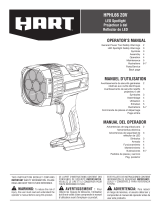
ENGLISH
3
into account the working conditions and the
work to be performed. Use of the power tool for
operations different from those intended could result
in a hazardoussituation.
5) Battery Tool Use and Care
a ) Recharge only with the charger specified by the
manufacturer. A charger that is suitable for one type
of battery pack may create a risk of fire when used
with another batterypack.
b ) Use power tools only with specifically designated
battery packs. Use of any other battery packs may
create a risk of injury andfire.
c ) When battery pack is not in use, keep it away
from other metal objects, like paper clips, coins,
keys, nails, screws, or other small metal objects,
that can make a connection from one terminal to
another. Shorting the battery terminals together may
cause burns or afire.
d ) Under abusive conditions, liquid may be ejected
from the battery; avoid contact. If contact
accidentally occurs, flush with water. If liquid
contacts eyes, additionally seek medical help.
Liquid ejected from the battery may cause irritation
orburns.
6) Service
a ) Have your power tool serviced by a qualified
repair person using only identical replacement
parts. This will ensure that the safety of the power
tool ismaintained.
Additional Safety Rules for Drain Snake
• Only grasp the cable with snug fitting leather work gloves
with latex gloves inside. Latex or loose fitting gloves or
rags can become wrapped around the cable and may
result in serious personalinjury.
• Stop the tool immediately if the cable binds and stops. The
cable can twist, kink or break ifoverstressed.
• Before starting work, know what is in the drain. Wear
safety equipment appropriate for the job (goggles, face
shields, protective clothing, respirator, etc.). Drains may
contain hazardous chemicals or infectious substances
that could cause seriousinjury. Contact the chemical
manufacturers to get safety information.
• Do not eat or smoke while handling or operating the
drain snake. After handling or operating drain snake, use
hot, soapy water to wash hands and other body parts
exposed to drain contents. This will help reduce the risk of
health hazards due to exposure to hazardous chemicals or
infectioussubstances.
• Inspect cable for wear and damage beforeuse.
• If the cable is worn or damaged, replace the cable before
using the drain snake.
• Do not twist, kink or over bend cables. A broken cable may
result in serious personalinjury.
• Refer to the Cable Application Chart to identify the
appropriate size cable for the application. An incorrect
cable can twist, kink or break if overstressed.
• The drain cleaning process can damage floors and
other surfaces and can bemessy. Use appropriate
protective covers to prevent damage and hazards to
surroundingarea.
• The front of the drain snake should be no farther than 6"
(15 cm) from drain opening. If not possible, use additional
pipe and fittings to extend the drain. Exposing more than
6" (15 cm) of cable can cause twisting, kinking, breaking
or whipping of thecable.
• This tool is intended to be used by a single operator, so
that they alone are able to control feed and rotation
of the cable. If the cable stops rotating, the user must
immediately release the trigger to prevent twisting,
kinking, breaking or whipping of thecable.
• Operate the drain snake in reverse rotation only as
described in this manual. Running the tool in reverse for
extended periods can cause damage to the cable.
• Do not pull the trigger with the end of the cable outside
of the pipe.
Additional Safety Information
WARNING: ALWAYS use safety glasses. Everyday
eyeglasses are NOT safety glasses. Also use face or
dust mask if cutting operation is dusty. ALWAYS WEAR
CERTIFIED SAFETYEQUIPMENT:
• ANSI Z87.1 eye protection (CAN/CSA Z94.3),
• ANSI S12.6 (S3.19) hearing protection,
• NIOSH/OSHA/MSHA respiratoryprotection.
WARNING: Some dust created by power sanding,
sawing, grinding, drilling, and other construction
activities contains chemicals known to the State
of California to cause cancer, birth defects or
other reproductive harm. Some examples of these
chemicalsare:
• lead from lead-based paints,
• crystalline silica from bricks and cement and other
masonry products, and
• arsenic and chromium from chemically-
treatedlumber.
Your risk from these exposures varies, depending on how
often you do this type of work. To reduce your exposure to
these chemicals: work in a well ventilated area, and work with
approved safety equipment, such as those dust masks that are
specially designed to filter out microscopicparticles.
• Avoid prolonged contact with dust from power
sanding, sawing, grinding, drilling, and other
construction activities. Wear protective clothing and
wash exposed areas with soap and water. Allowing
dust to get into your mouth, eyes, or lay on the skin may
promote absorption of harmfulchemicals.
WARNING: Use of this tool can generate and/
or disperse dust, which may cause serious and
permanent respiratory or other injury. Always use
NIOSH/OSHA approved respiratory protection
appropriate for the dust exposure. Direct particles
away from face andbody.













